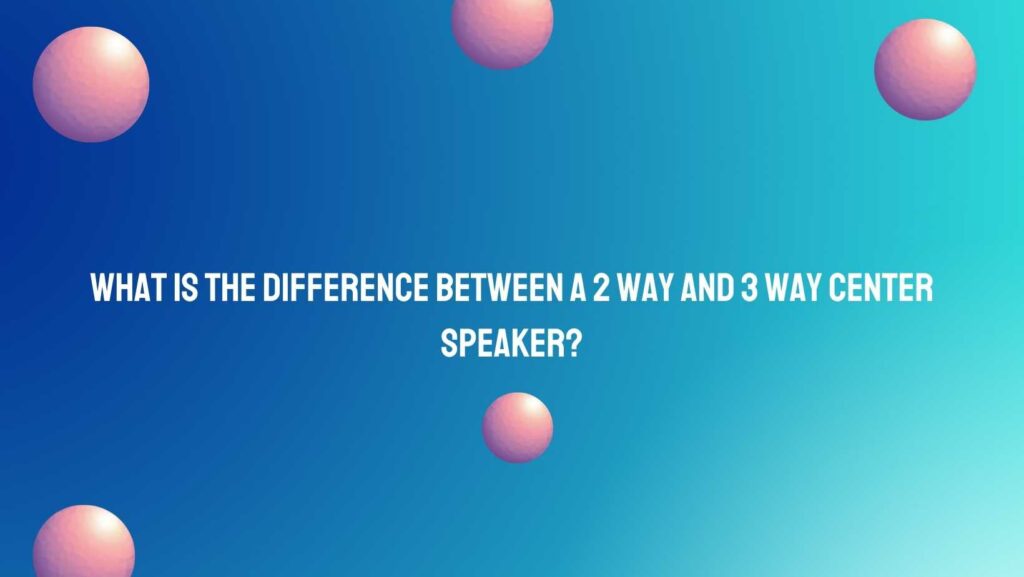The world of home theater and audio systems is filled with various speaker configurations and designs, and center speakers play a pivotal role in delivering clear dialogue and sound localization in a surround sound setup. Two of the most common center speaker types are 2-way and 3-way designs, each offering distinct features and benefits. In this comprehensive guide, we will explore the key differences between 2-way and 3-way center speakers to help you make an informed decision when selecting the right center channel for your home theater setup.
Understanding Speaker Terminology
Before delving into the differences between 2-way and 3-way center speakers, it’s essential to understand some fundamental speaker terminology:
- Drivers: Speakers consist of different drivers, which are individual components responsible for reproducing specific frequency ranges. The most common types are woofers (for bass frequencies), midrange drivers (for midrange frequencies), and tweeters (for high frequencies).
- Crossover: A crossover is an internal component within a speaker that divides the audio signal into different frequency ranges and directs them to the appropriate driver. This ensures that each driver only reproduces the frequencies it is designed for, leading to a cleaner and more accurate sound reproduction.
- Frequency Range: This refers to the range of frequencies a speaker can reproduce. In a center speaker, the most important range is usually the midrange, where most dialogue and critical sound effects in movies and TV shows are located.
A 2-way center speaker typically features two types of drivers: a woofer for handling bass frequencies and a tweeter for high frequencies. Here’s what sets them apart:
Key Features:
- Woofer and Tweeter: The 2-way center speaker uses a woofer and a tweeter to cover the necessary frequency ranges. The woofer handles the lower frequencies, while the tweeter takes care of the higher frequencies.
- Simplified Design: The 2-way design is relatively simple, making these speakers compact and more affordable compared to 3-way center speakers.
- Dialogue Clarity: 2-way center speakers excel at delivering clear and crisp dialogue, making them ideal for home theater setups where speech intelligibility is crucial.
3-way center speakers are equipped with an additional midrange driver, making them capable of reproducing an extended range of frequencies. Here’s what distinguishes them:
Key Features:
- Woofer, Midrange, and Tweeter: The 3-way design includes a woofer, a dedicated midrange driver, and a tweeter. The midrange driver covers the frequencies in between the woofer and tweeter, enhancing sound accuracy.
- Expanded Frequency Range: 3-way center speakers offer a wider frequency range, resulting in more detailed and accurate sound reproduction, particularly in the midrange frequencies.
- Improved Soundstage: Thanks to the dedicated midrange driver, 3-way center speakers often deliver a more expansive soundstage, enhancing sound localization and immersion in a home theater environment.
- Reduced Distortion: The dedicated midrange driver reduces distortion and intermodulation effects, improving the overall sound quality.
Choosing Between 2-Way and 3-Way Center Speakers
When deciding between a 2-way and 3-way center speaker, consider the following factors:
- Room Size: In smaller rooms or setups where space is limited, a 2-way center speaker may suffice to provide clear dialogue and audio.
- Sound Quality: If you prioritize high-quality audio and want an immersive home theater experience with improved soundstage, a 3-way center speaker is the better choice.
- Budget: 2-way center speakers are generally more affordable than their 3-way counterparts. Consider your budget and how much you’re willing to invest in your audio setup.
- Preference: Ultimately, your choice may come down to your personal preferences and your specific audio requirements. Consider your listening habits and expectations for your home theater.
Conclusion
The choice between a 2-way and 3-way center speaker ultimately depends on your room size, budget, and audio quality expectations. While 2-way speakers excel at delivering clear dialogue, 3-way speakers offer an extended frequency range, improved soundstage, and reduced distortion, making them ideal for those who prioritize immersive and high-fidelity sound reproduction. Carefully assess your requirements and preferences to select the center speaker that best complements your home theater system and delivers the audio experience you desire.

